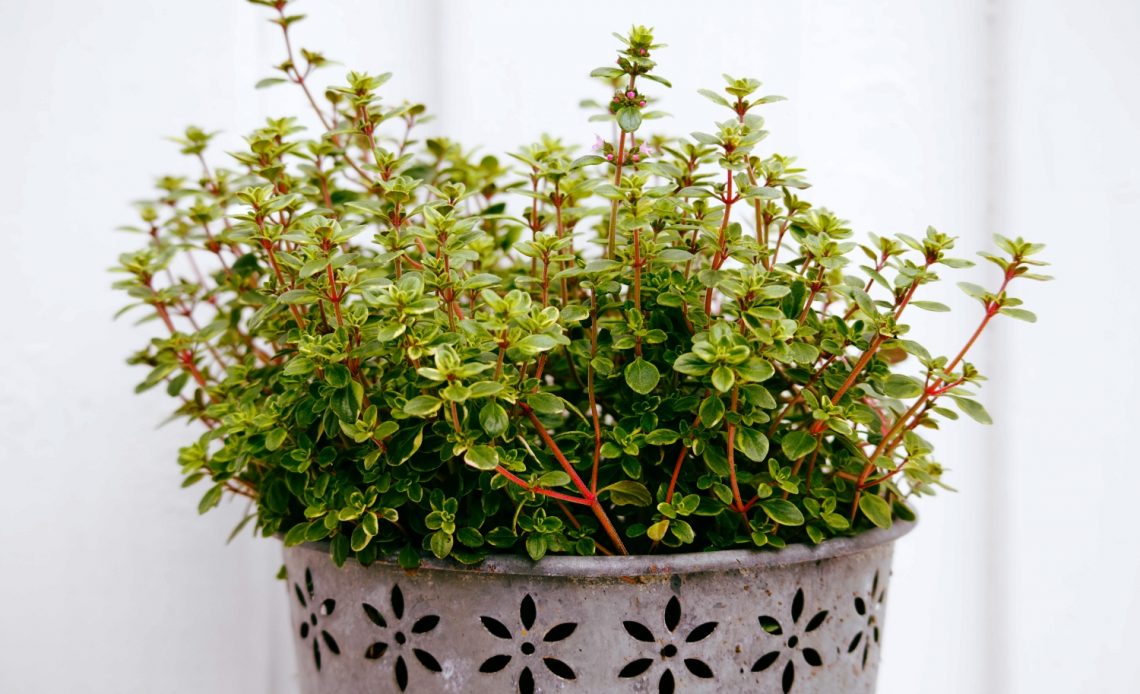

We’re here to help! Wild Yards is a completely free website that is 100% dedicated to helping you create a wildlife-friendly, sustainable yard. Read more
WildYards is reader-supported. When you buy a product through a link on our site, we may earn a comission. Every product is independently selected by our (obsessive) editors and our reviews are unbiased and objective. Read more about our mission or our privacy policy.
You can’t grow an herb garden without including some thyme. This flavorful herb is both sweet and savory, adding undertones of mint and pepper to your homemade casseroles, soups, and stews.
Fresh thyme makes a world of difference in your cooking. And the good news is, it’s just as easy to grow as it is to eat!
Thyme is a fast-growing herb. Some gardeners even consider it to be invasive.
If you just repotted some thyme plants that were started from cuttings, or if you’re new to growing thyme and you want to keep your little plant alive, you’re probably wondering, how can you harvest thyme without killing the plant?
The good news is, thyme is pretty forgiving, even if you overharvest a little bit. But there’s still a right way to harvest and a wrong way to harvest.
When harvesting thyme, always use sharp pruning shears. Don’t be afraid to harvest a good portion of established plants, as this stimulates new growth. It’s best to harvest thyme in early summer before the plants begin flowering.
How to harvest thyme without killing the plant
Thyme is a great plant for beginner herb gardeners because it’s unflappable.
Once the plant becomes established, it can be difficult to get rid of. So if you were to accidentally harvest too much, or harvest cuttings incorrectly, the plant would likely have little trouble bouncing back.
That said, it never hurts to do something the right way the first time!
When it comes to harvesting thyme, the process is pretty simple. But there are a few things you’ll need to keep in mind to avoid damaging the plant.
To start, grab a pair of sharp scissors or pruning shears. Never pick thyme cuttings by hand, as this can hurt the foliage.
If your thyme is healthy and well-established, you’ll notice the plant grows in clusters.
Take as much of the foliage in one hand as possible, then use your scissors to trim the plant an inch or two above the base.
When pruning established thyme, it’s okay to harvest large quantities. You just need to make sure you leave a little bit of green foliage at the base of the plant so that it can regenerate.
Avoid overharvesting young plants. Take only a few cuttings at once so you don’t stress the plant.
If your thyme is a mature plant, then you’ll notice the undergrowth is quite woody.
In this case, you’ll need to leave an inch or two of green stems above the woody growth when you harvest the cuttings.
It’s very difficult for herbs like thyme (and rosemary and lavender as well) to grow new leaves from woody stems. Pruning too harshly into the woody undergrowth can kill the plant.
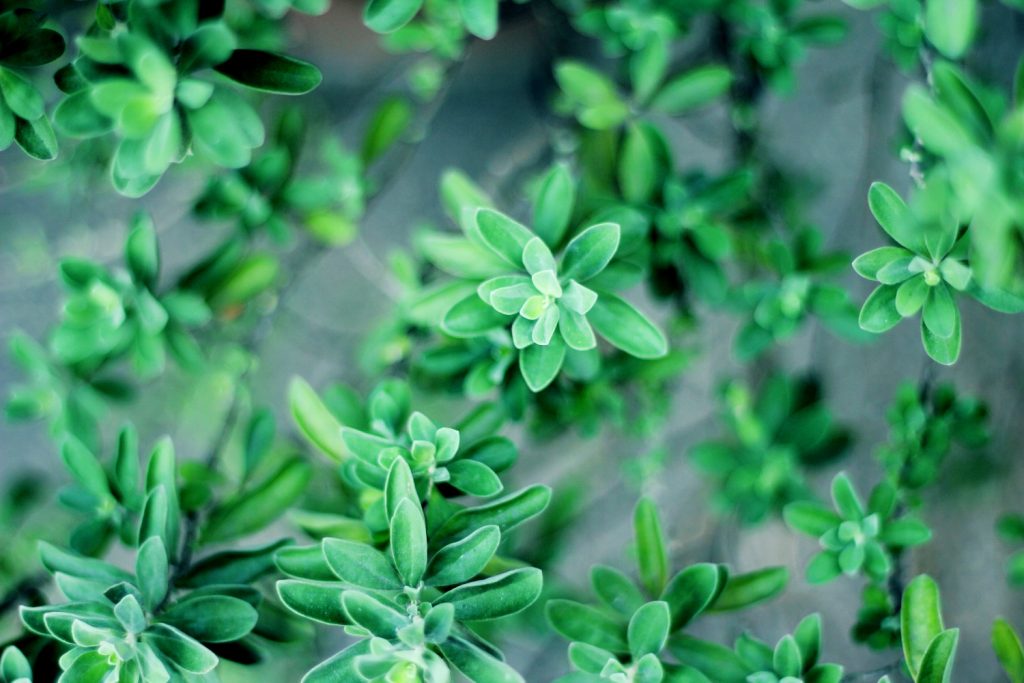
When should you harvest thyme cuttings?
Hardy from zones 4 through 9, thyme is grown as a perennial in warmer regions, but cannot withstand the cold winters of cooler growing zones.
If you’re growing your thyme as an annual, then you can harvest a sprig or two whenever you like to use it in your cooking.
However, if you prefer to harvest large quantities of thyme at once to store for later, you can harvest up to a third of the plant in early summer, and do a major harvest before the first frost of autumn.
The process is a bit different if you’re growing thyme as a perennial.
For mature, established thyme plants, you’ll need to harvest in early summer at the peak of the plant’s growth stage before they begin flowering.
Harvesting thyme at this period results in more flavorful sprigs. The sprigs contain high levels of essential oils, so they really pack a punch in the kitchen. They also tend to be much more tender.
Trim the thyme sprigs when they measure 8 to 10 inches. Be sure to harvest your thyme cuttings early in the morning, as this is when the concentration of oils is highest.
When growing thyme perennially, you’ll be supporting plant growth by harvesting the majority of the cuttings in early summer.
That said, you can still harvest a sprig or two during the flowering season and afterward. However, the sprigs you harvest will have a much milder flavor.
Whether you intend to eat the sprigs, start new plants, or just toss them onto your compost heap, trimming your thyme supports healthy foliage development by stimulating new growth.
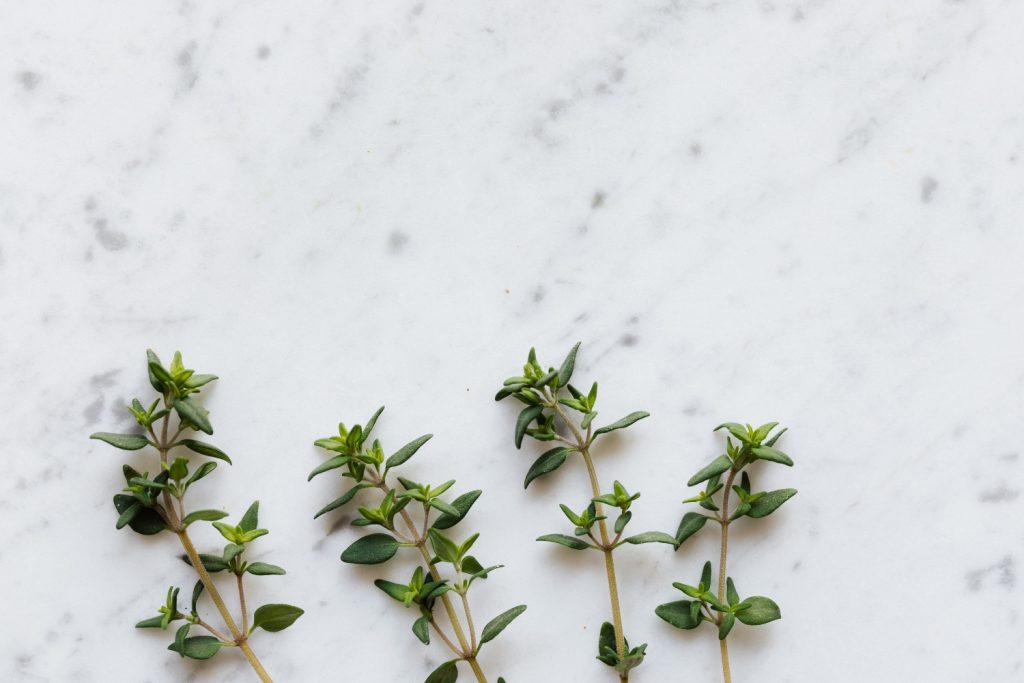
What’s the best way to store thyme?
How you store your thyme cuttings depends on how you intend to use them.
Fresh thyme is delicious in Italian foods and other tomato-based dishes. You can even use fresh thyme sprigs to add flavor to your jams and jellies.
But when dried, your thyme cuttings will last much longer. And, if you harvest your sprigs at the right time, they will retain their potent flavor.
Refrigerating thyme cuttings
If you would rather use your thyme cuttings fresh, then all you need to do is toss the sprigs into a colander, rinse them in cool water, pat them dry, and stick them in the crisper drawer of your fridge with your fruits and veggies.
You can store the cuttings in a sealed plastic container. This will keep the sprigs fresh for a few weeks.
A plastic Ziploc bag will work just fine, too, but be sure to line it with a damp paper towel. This will keep the sprigs hydrated so they stay crisp and juicy for 2 to 4 days.
Alternatively, you can place the sprigs cut-side-down into a glass, and fill the glass with an inch or two of water, as if you were going to propagate the plants.
This keeps the sprigs fresh for days to weeks. Just be sure to replace the water regularly to prevent it from becoming cloudy.
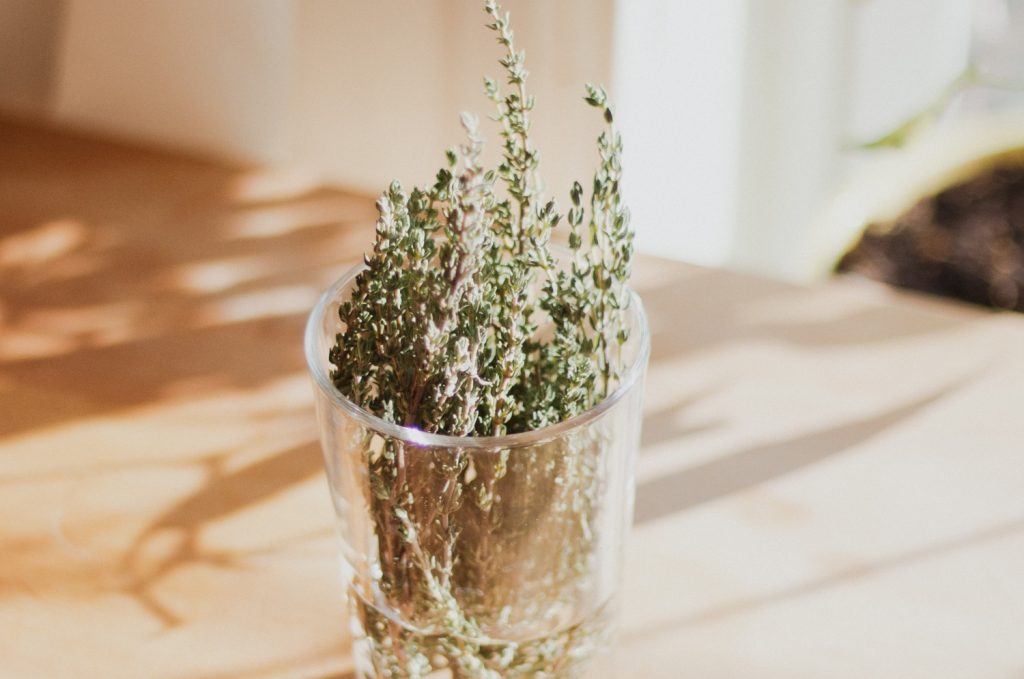
Freezing thyme cuttings
Your fresh thyme cuttings can also be frozen. After washing and drying them, simply place the sprigs you wish to keep for later in a large freezer bag.
Frozen thyme cuttings will stay fresh for 6 to 12 months.
You may want to double-bag the thyme to prevent freezer burn.
Freezing thyme cuttings makes cooking a breeze. You can pull as many sprigs from the freezer as you need, chop them up, and place the extras back in the fridge.
Frozen thyme is the next best thing to fresh thyme.
Air drying thyme cuttings
Of course, you can always dry your thyme cuttings, too.
Rinse the cuttings in cool water, and use a tea towel to pat away excess moisture. Then, spread the sprigs out on a towel or baking sheet to finish air drying.
Once the sprigs have dried thoroughly, gather them in small handfuls and tie them together with twine.
Hang the thyme cuttings up in a cool, dry, dark place for 3 to 6 weeks.
Once the cuttings are dry, gently rub the leaves off of them and add the remaining twigs to your compost bucket.
Be sure to collect the dried leaves in a large bowl and transfer them to a container when you’re finished.
Dried thyme can last for years when stored in an herb rack, in a cool, dark place.
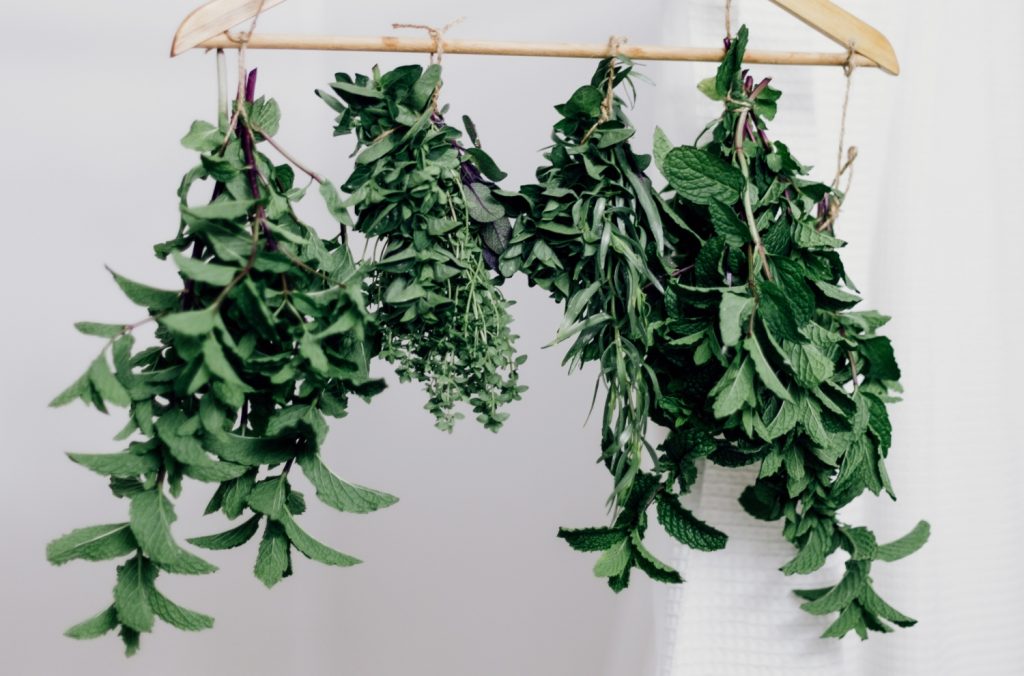
Dehydrating thyme cuttings
Maybe you don’t want to wait weeks for dried thyme. Maybe you want your thyme to dry right now.
If you don’t have time to wait for your, ahem, thyme, then dry it quickly by placing it in your food dehydrator.
Arrange the sprigs in a single layer onto the trays of your dehydrator and follow the manufacturer’s instructions.
Dehydrating thyme eliminates the potential for mold to develop. It also dries your thyme in a matter of hours, compared to air drying, which can take more than a month.
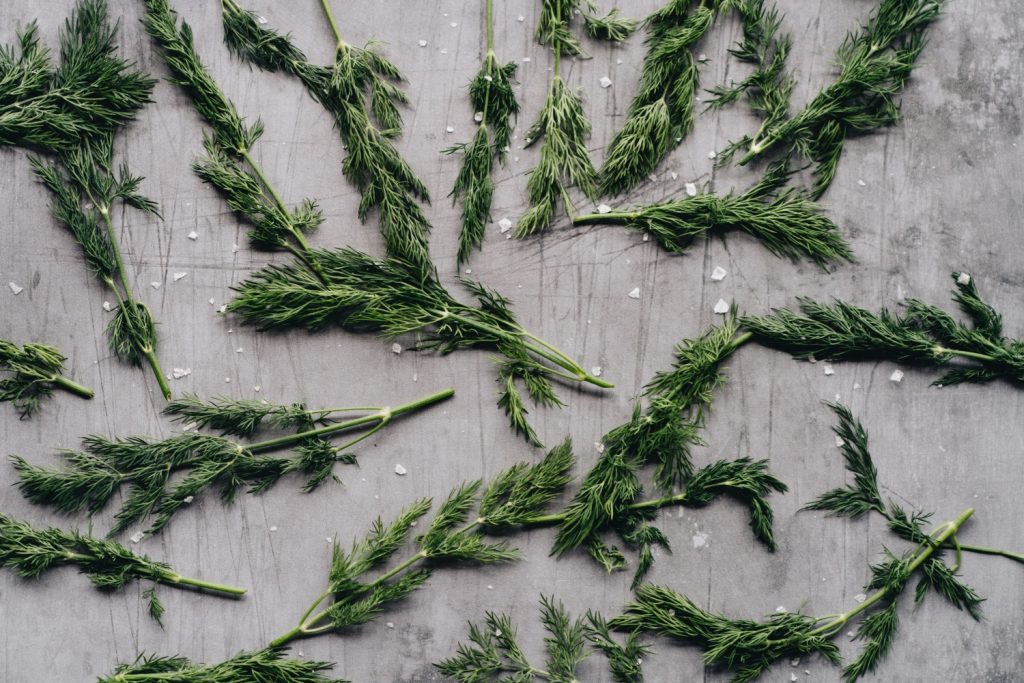
Making thyme essential oil
Another way to make use of your thyme cuttings is by making essential oil.
Thyme essential oil has antimicrobial properties, inhibiting the growth and development of certain fungi, bacteria, and viruses.
It also has anti-inflammatory effects and works to relieve digestive, respiratory, and skin ailments.
To make your own thyme essential oil from fresh cuttings, first, wash and dry the thyme sprigs as you would if you were going to refrigerate or freeze them.
Once the sprigs are clean, crush them using a mortar and pestle. This will release the plant’s oils. You don’t have to go overboard here, just gently crush the cuttings.
Next, toss the thyme into a saucepan and cover them with a cup of oil — light olive oil works best.
Heat the oil slowly over medium heat until bubbles begin to form. Allow the mixture to simmer lightly for 5 minutes, then remove it from the stove.
Strain the sprigs from the oil, and pour the oil into a glass container. Be sure to label the mixture, especially if you have other homemade essential oils lying around.
Store your thyme essential oil in a cool, dark place, or even in your refrigerator.
How can you prepare thyme for winter?
If you’re growing your thyme as an annual, then after your final harvest in autumn, there’s no need to take any action to protect the plants. In fact, you can remove them and add them to your compost heap to provide sustenance for the plants in your garden next year.
But if you’d prefer to grow your thyme as a perennial, you’ll need to protect the plants during the winter.
Thyme is native to the Mediterranean region, where it stays hot and dry much of the year.
This plant is quite sensitive to cold temperatures, and will not survive for long once the mercury dips below freezing.
Be sure to bring potted thyme plants indoors, and keep them in a warm place. One of the benefits of growing plants in containers is that you can easily move them indoors until conditions improve.
Because winter is the plant’s dormancy period, it won’t grow much during this time. Refrain from harvesting any cuttings from the plant in the winter to avoid stunting its growth during the next season.
For plants growing outdoors, be sure to cover them with old sheets, rags, a packing blanket, or a tarp to protect them from frost.
Applying a layer of mulch is also a good idea because this helps keep the roots warm.
Thyme is drought tolerant and typically doesn’t need to be watered over the winter.
So after your final harvest in autumn, double-check the soil’s drainage. If the soil retains too much water, mix in some horticultural sand to prevent excess water from pooling at the roots and contributing to root rot.
Taking good care of your thyme over the winter months enables the plant to produce delicious, potent cuttings during the next growing season.
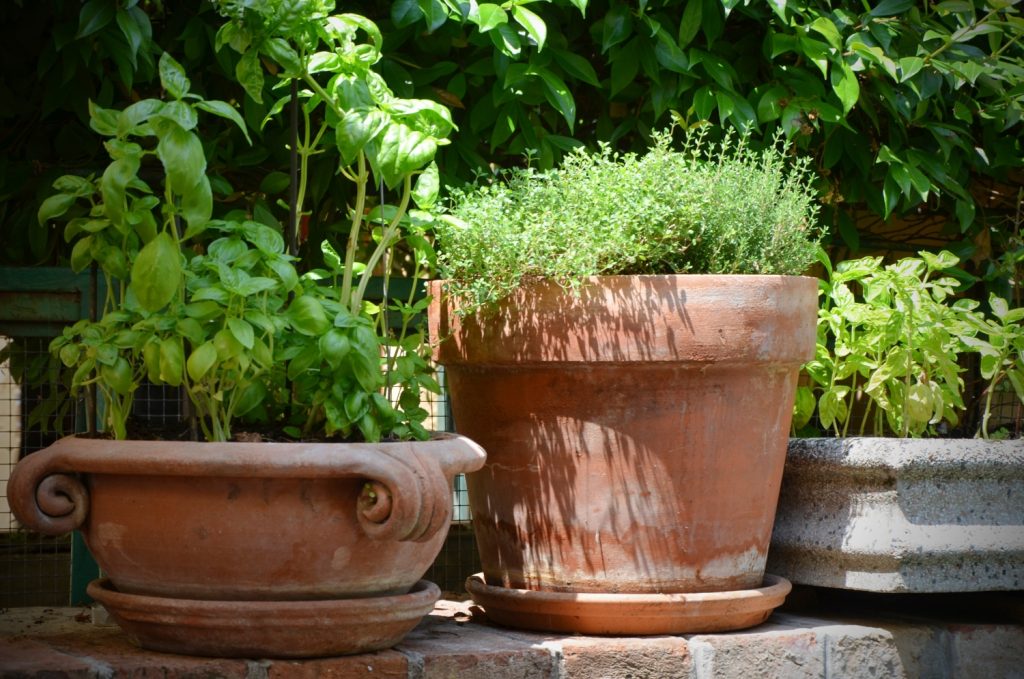
Does harvesting thyme hurt the plant?
There are hundreds of varieties of thyme to choose from. Many of them are grown for their culinary uses. But some, like red creeping thyme, are usually grown for their aesthetics and their low-maintenance nature.
Regardless of which type of thyme you choose to grow, and regardless of where you choose to grow it, thyme typically benefits from being pruned.
And not just lightly pruned. Heavily pruned. Thyme can take a licking and keep on ticking.
When you harvest thyme, as long as you do so correctly, you encourage the plant to keep growing.
Removing new growth stimulates the plant. Pruning tells the plant to focus on producing more foliage to replace what was lost.
Even if you’re only growing thyme as a ground cover to replace the grass in your lawn, it still benefits from being pruned.
Going over the thyme with shears or a push lawnmower encourages dense foliage growth, so the plants stay low-growing and don’t become leggy.
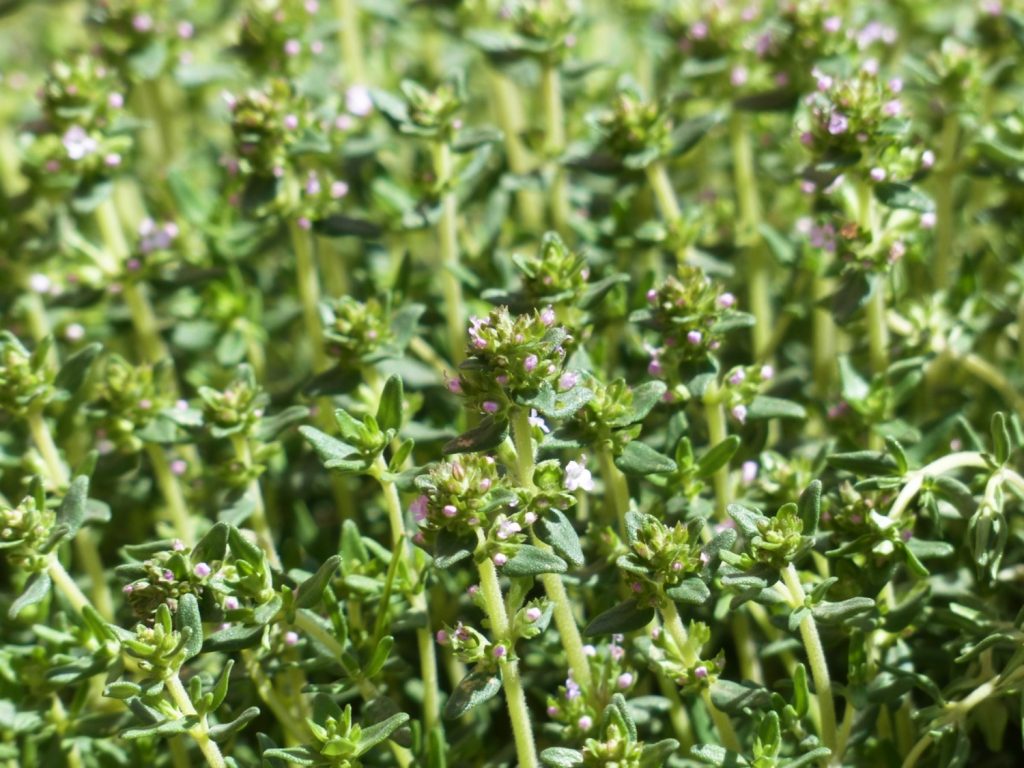
What can you do to support healthy thyme cuttings?
If you want to harvest the best thyme cuttings possible, then you’ll need to pay close attention to your plant’s health.
Meeting all of your thyme’s growing requirements is a surefire way to produce delicious, potent foliage.
Remember, thyme is native to the Mediterranean region. It likes hot, dry conditions.
Plant your thyme in a sunny spot where it will receive 6 or more hours of direct light. If you live in a particularly hot climate, your thyme may benefit from afternoon shade.
Be sure to amend your native soil to suit your thyme plant’s needs.
Thyme does not require fertile soil to produce. What it really needs is excellent drainage. Thyme grows best in sandy to loamy soils with a pH of 6.5 to 7.0.
If your soil is too sandy, use compost, manure, and worm castings to give it a small dose of nutrients.
If your soil is too fertile, add horticultural sand or perlite to make it looser and to reduce water retention.
The benefits of pruning thyme plants
Pruning your thyme annually improves air circulation around the plant. Since thyme prefers to grow in dry, arid regions, this supports the plant’s overall health.
Improved air circulation prevents fungal and bacterial pathogens from setting in.
Thyme can be prone to root rot and powdery mildew, but adequate airflow helps fight these potentially deadly diseases.
Trimming away the excess foliage also exposes the plant to the sunlight. The more light your thyme plants receive, the better they will grow.
Thyme is a semi-evergreen, meaning it retains much of its foliage over the winter. Ensuring the plants get plenty of sunlight also helps them survive the cooler weather.
Harvesting your thyme at the right point in its growth cycle is key to collecting potent sprigs. But it’s also key to stimulating new growth.
Trimming thyme cuttings as the plant is kickstarting its growth for the season allows the plants to recover from pruning more quickly.
It also encourages the plant to produce dense foliage, promoting a better, more manicured shape.
Lastly, because thyme can become invasive, pruning the plant helps keep its growth rate in check. Harvesting the foliage forces the plant to devote its resources to replacing what was lost, rather than spreading to other parts of your vegetable garden or flower beds.
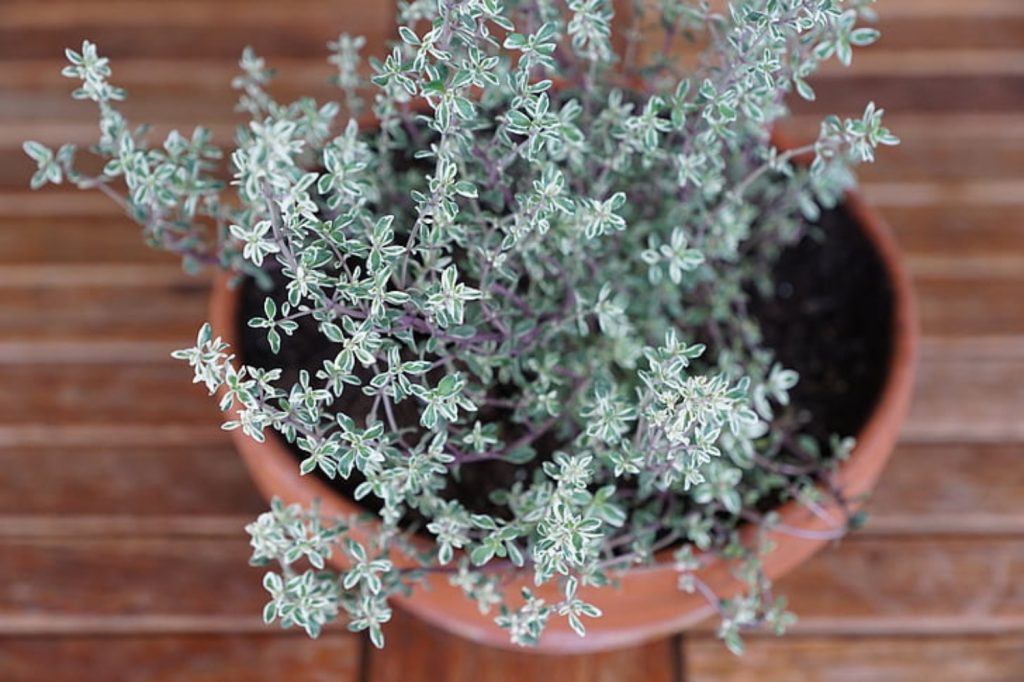
More tips for harvesting thyme successfully
To harvest the best thyme sprigs possible, avoid taking cuttings on a rainy or particularly humid day.
The extra dampness can make drying these sprigs difficult.
Only harvest large quantities from mature and well-established plants. These plants have strong, sturdy root systems that enable them to recover from the pruning process much more quickly.
For young plants, it’s best to harvest only small handfuls at a time.
If you’re not sure how much to harvest from your new thyme plants, a good rule of thumb is to trim no more than a third of the plant.
The right tools will also allow you to harvest thyme successfully. Using scissors or shears, rather than your hands, prevents unnecessary damage to the plant.
Just be sure to sterilize your equipment after harvesting thyme cuttings. Use a dilution of 1 part bleach and 9 parts water to spray down your scissors and shears. This way, you can avoid spreading pathogens to the other herbs in your garden.
By taking a few precautions and following all of the necessary steps, you can successfully harvest a delicious thyme crop without killing the plant.
